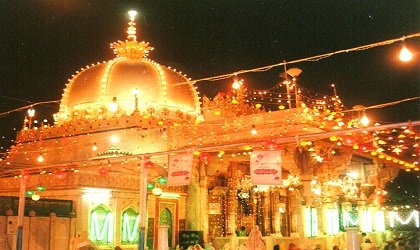The dargah of Moinuddin Chishti (Gharib Nawaz – Advocate of Poor people), is a universal waqf, Islamic mortmain overseen by the Dargah Khwaja Saheb Act, 1955 of the Administration of India.
Ajmer Sharif Dargah is additionally known by the name of Dargah Sharif, Khawaja Gharibnawaz Dargah Ajmer, Ajmer Dargah, Ajmer Sharif. It is the most prevalent and imperative Muslim journey in Rajasthan. Individuals from every one of the networks come here and pay respect in the dargah of Khwaja Moinuddin Chishti at Ajmer Sharif. Ajmer Sharif is popular for satisfying the desires of the lovers. Different adherents of various religions offer blooms, velvet material, fragrance (non-alcoholic), and sandalwood at the Dargah.
History of Ajmer Sharif :
Khawaja Gharib Nawaz Dargah Ajmer is the tomb of the Hazrat Khwaja Moin-d-noise Chisti, who was the author of Islam in India and known as an incredible evangelist of Islam on the planet. He was known for his respectable lessons and harmony. This Sufi holy person is known to have originated from Persia and passed on in 1236 in Ajmer subsequent to winning all hearts. Otherwise called “Khwaja Garib”
Later Mughal ruler Humayun, Akbar, Shahjahan, and Jahangir built mosques here. Primary tomb entryway is known as Nizam Door which was raised by Shahjahan so it is additionally called Shahjahani Entryway. After it, there is Buland Darwaja. Urs banner is raised on it which denotes the start of the Urs celebration.
Khidmat: This custom is cleaning of Mazar and contributions by blossoms. Khidmat is completed two times each day. One at 4:00 am with the call of azan and the second at 3:00 pm. Morning Khidmat is performed 30 minutes before the Fajar petition and night khidmat is performed just by men. Women are not permitted the khidmat and offering of blossoms and sandalwood with the khadim discussing fateha.
Lighting (Ros): Khadims carry candles inside the tomb with the pounding of drums and lights up the lights in the four corners with the recitations of sacrosanct words.
Karka: This is the end function of the tomb and happens following an hour of the isha petition. Before 20 minutes of shutting the entryway when the fifth piece of the night passes, the clock sounds multiple times. The fans requested to leave the tomb and three khadims clean the tomb. After that chime rings multiple times to stamp the qawwals sing an uncommon karka tune and the entryway is shut after that.
Sama (Qawwali): It is the tune in the commendation of Allah which is sung by qawwals who are reverential artists at the Mehfil-e-Sama before the Mazar after all namaz are finished. Likewise, Quran presentation happens each day.
The biggest Muslim reasonable in India, the yearly Urs of the Sufi holy person Khwaja Moinuddin Chishti is held at the dargah of the holy person in Ajmer, Rajasthan. The Urs festivities proceed for six days, beginning with the raising of a white banner on the tomb by the Sajdanashin (successor-agent) of the Chishti request. Throughout the days which pursue, the tomb is ceremonially blessed with rosewater and sandalwood glue; qawwali are sung and verse presented in recognition of the All-powerful, petitions are stated, qawwalis and other a few projects the entire night to make fellowship and satisfaction among individuals of various foundations and aficionados offer nazranas or votive contributions. Outside the dargah regions, two monstrous cauldrons cook sweet rice embellished with dry products of the soil to be filled in as ‘tabarukh’ or purified sustenance. The yearly celebration of Urs begins with banner lifting at Buland Darwaja. The Urs celebration begins once the moon shows up in the long stretch of Rajab. With the initiation of the Urs celebration, the day by day timetable of the Dargah changes. The fundamental passage of the heavenly tomb which used to shut during the evening is currently open throughout the day and night aside from 2 or 3 hours around the evening time.
Qul Day: It is the latest day of the Urs celebration which is the 6th day of the celebration. It is a most vital day of the celebration and after morning supplication aficionados begin to accumulate at the heavenly tomb. After that exercise incorporates a presentation of the Quran, Darood, harmony, Shijra-e-Chishtia, and different stanzas. Fans likewise attach little turbans and appeal to God for harmony, satisfaction, and flourishing.
